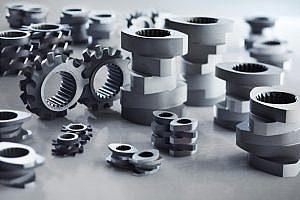Heating and Cooling in the Screw and Barrel
The screw and barrel assembly is the core section of an extruder, where the polymer is fed, melted, conveyed, mixed, devolatilized, and finally pumped to the die. Both the screw and barrel sections are designed to be modular, allowing them to be configured in different layouts to suit specific extrusion process requirements.
Modular Design of Barrel Sections
Barrel sections typically come in either rectangular or circular outer shapes, depending on the manufacturer. These sections are assembled either by inserting a long central rod or using bolts to hold them together. To maintain structural integrity, the barrel is supported at various points along its length to prevent sagging. Each section includes a thermocouple to precisely control the heating and cooling system.
Heating and Cooling System Components
The heating and cooling system of the barrel includes:
-
Heater bands.
-
Cooling elements.
-
Vent caps.
-
Insulated barrel covers.
-
Barrel support structures.
Each barrel section is equipped with flanges at both ends to ensure proper alignment and easy connection to adjacent sections. Although reconfiguring barrel sections is a detailed task, it is possible to disassemble, rearrange, and reassemble them to reposition feed or vacuum (vent) zones as needed.
Some smaller extruder models feature a clamshell barrel design, where the barrel splits open in the middle, providing full exposure of the screw. Unlike modular barrels, clamshell barrels are constructed as a single unit and are ideal for maintenance or cleaning. These systems also feature individual heating and cooling zones, offering accurate temperature control, much like water-cooled single-screw extruders.
Barrel Length-to-Diameter Ratios (L/D)
Similar to screws, barrel sections are available in different length-to-diameter ratios (L/Ds), which depend on screw size and manufacturer specifications. Common L/D ratios include:
2.5, 3, 4, 5, 6, 8, 10, and 12.
Types of Barrel Sections
Various barrel section types are used to perform specific functions within the extruder:
-
Vent Barrel: Features a top opening (circular or rectangular) used to vent volatiles or feed other formulation components.
-
Combi Barrel: Includes a side feeding port and a vent on top.
-
Closed Barrel: A solid barrel section with no openings, used for standard melt processing.
The first barrel section in most extruders includes a top feed opening for introducing the main formulation. This section is cooled and usually lacks side heaters. Other vent or feed sections have a top opening surrounded by cast heaters on three sides. For example, barrel section 2, located right after the feed throat, typically includes a vent plug, and it is both heated and cooled based on process requirements.

